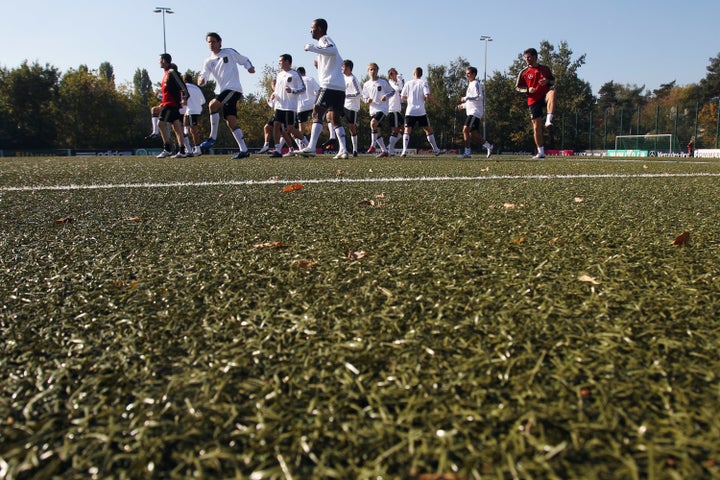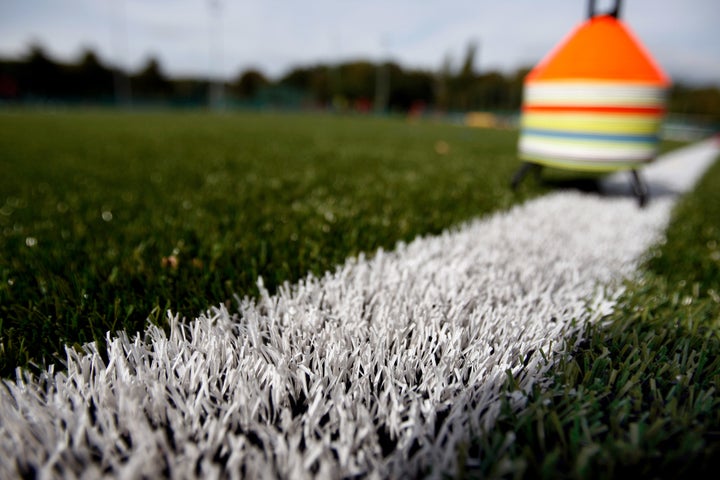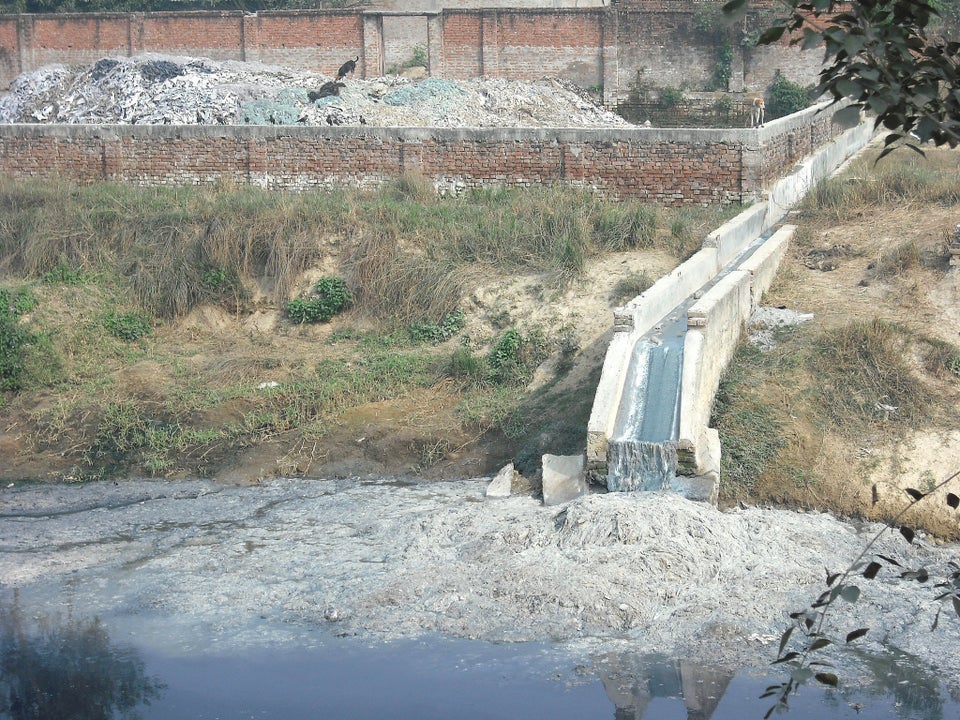
The federal government launched a new effort in February to study health concerns related to synthetic turf, as worries grow about possible cancer risks to the millions of athletes who play on artificial fields across the country.
Now, a former top soccer player who helped convince the feds to investigate the issue says more than 200 athletes have reached out to her after being diagnosed with cancer.
Amy Griffin, a goalkeeper for the U.S. National team that won the first women’s World Cup in 1991, has been informally tracking American soccer players with cancer since 2009, when she noticed a “stream of kids” who’d played soccer on artificial fields were getting sick.
Griffin, now an associate head coach for the University of Washington women’s soccer team, told NBC in 2014 that she’d heard from 38 soccer players who’d been diagnosed with cancer. That tally has climbed to 220 athletes -- 166 of them soccer players.
Of the soccer players, 102 were former goalkeepers like Griffin. They spent more time on the ground and were more exposed to crumb rubber -- the tiny rubber pellets found in artificial turf -- than their teammates.
"I am not making any claims about what is happening with these players,” Griffin said. “But this problem isn't fading. It's going the other way."
“"This problem isn't fading. It's going the other way."”
- Amy Griffin, associate head coach, University of Washington women’s soccer team
It hasn’t been scientifically proven that athletes exposed to crumb rubber have higher rates of cancer than the general population, and the synthetic turf industry insists its product is safe. Research shows that crumb-rubber pellets, made of recycled tires, can contain toxic chemicals, metals and carcinogens, but not necessarily at levels that threaten human health.
But the current lack of scientific consensus on the issue underscores why additional federal research is important. The last time the Environmental Protection Agency studied crumb rubber in 2009, it found potentially harmful substances in the material, but only enough to merit a “low level of concern.”
This year, the EPA said it could no longer stand by that study -- which was limited to four crumb-rubber fields -- and announced a follow-up study with other federal agencies that will evaluate existing research, test different kinds of tire crumb and involve outreach to the public, including athletes and parents.
Existing studies by federal, state and local government agencies “were not designed, nor were they sufficient in size or scope, to draw conclusions about the safety of all fields across the nation,” EPA spokeswoman Laura Allen told The Huffington Post. “They cannot fully answer questions about what if any potential risks might be posed from exposure.”
Griffin acknowledges that her list is not scientific, but says it represents an effort to bolster the anecdotal evidence she’d been seeing with numbers. “When my gut instinct and science starts to match up,” she said, “that’s a scary thing.”
Griffin started keeping her list in 2009, after two goalkeeper friends found out they had lymphoma. Both suspected their illnesses had something to do with those “little black dots” that they played on for countless hours, she said.
“I lived on the stuff,” former UW goalkeeper Jorden Alerding told Seattle’s KOMO News. Aldering is now cancer-free, but Griffin’s other friend who was diagnosed with lymphoma, Austen Everett, died in 2012.
Griffin started seeing more soccer players get diagnosed with cancer. The UW coach would visit patients at Seattle Children’s Hospital with her team, and one year, three of the four patients they visited were child goalkeepers battling lymphoma.
At first, Griffin says, she only documented the cancer cases of people she knew through her work or personal life. But as her efforts garnered attention, other players who had been diagnosed started coming forward. She recorded their name, birthdate, type of cancer, date of diagnosis, status of their condition (in treatment, remission or deceased), the position they played, the locations they played, the number of hours they spent on the field per week and the number of years they spent playing the sport.
Griffin wanted to ensure that the data she collected was as accurate as possible, so she submitted it to the Department of Health to check that the names were also in the agency’s cancer registry.

The majority of the athletes on Griffin’s list have been diagnosed with lymphoma, and the next most frequent type of cancer they’ve reported is leukemia. While the athletes range in age, she says most of them were born in the late-1980s to mid-1990s and were active around the time that turf fields became more common.
Ethan Zohn, a former professional goalkeeper who was diagnosed with Hodgkin lymphoma in 2009, has kept a list like Griffin’s. When HuffPost spoke to Zohn in 2014, the majority of the 50 or so players on his list had been diagnosed with lymphoma.
Lymphoma and leukemia are among the most common types of cancer for young adults, according to the American Cancer Society and the National Cancer Institute. But the prevalence of lymphoma cases in Griffin’s research was a red flag for David Brown, a public health toxicologist who worked for the Centers for Disease Control and Prevention and now serves as the director of public health toxicology for the nonprofit Environment and Human Health, Inc.
“You should never get more lymphomas than leukemias,” Brown told former U.S. Women’s National Team member Julie Foudy in a piece she wrote for ESPN last November. “Leukemias are the most prevalent cancer in that [younger] group, and [Amy’s list] has more lymphomas ... her ratios are upside down.”
The inverted data “signals that there’s a chemical involved,” Brown said.
“This is the largest failing of the government I’ve seen in my lifetime. ... A whole generation is at risk.””
- Nancy Alderman, president of Environment and Human Health, Inc.
There are currently more than 11,000 synthetic fields at schools and parks around the country. The fields, used by children and professional athletes alike, each typically contain between 20,000 to 30,000 ground-up tires. Mercury, benzene and arsenic are just a few of the potentially harmful chemicals they contain, and older turf fields have also been found to contain higher levels of lead, according to reports from the EPA and California Office of Environmental Health Hazard Assessment.
Advocates of synthetic turf fields say they are more affordable and durable, require less water and maintenance, and stay in better shape longer.
But athletes aren’t sold on them. In addition to the health concerns, many players say that the tough turf leads to more injuries and changes the way the ball moves.
The crumb rubber and plastic grass blades can lead to abrasions and turf burns, and because the fields can reach a hotter surface temperature, athletes are more at risk of overheating and dehydration. On an 82-degree day during a UW summer soccer camp, a thermometer placed into the turf registered over 200 degrees Fahrenheit, Griffin told HuffPost in 2014.
A 2013 survey of top female soccer players found that they were 80 percent less likely to slide tackle on synthetic fields. An overwhelming majority of Major League Soccer players in a different 2013 survey said the crumb-rubber fields would increase the risk of injury and physical discomfort and prolong recovery times. One study suggested that the artificial fields put additional strain on players’ joints and muscles, while another found that the best way to prevent ACL injuries is to use cleats on real grass, not the synthetic version.
In 2014, 40 top women’s soccer players, including U.S. National Team Members Abby Wambach and Alex Morgan, sued FIFA for gender discrimination because the 2015 Women’s World Cup would be played on synthetic turf. Every Men’s World Cup since the tournament began in 1930 has been played on natural grass.
“Not only are they long-lasting injuries, but there are long-term effects of playing on turf,” Morgan said. In 2013, U.S. forward Sydney Leroux posted a picture on Twitter showing abrasions she had on her legs from sliding on artificial turf. “This is why soccer should be played on grass!” she wrote.
The players eventually dropped their lawsuit in January 2015 after encountering stiff resistance from the tournament organizers and reportedly being intimidated by soccer federations. In the end, they had to compete on artificial turf.
Mounting pressure from communities, advocates and politicians is partly why federal agencies are now conducting new research on artificial turf.
But some worry that the government has already taken too long to act on this issue. “In my opinion, this is the largest failing of the government I’ve seen in my lifetime,” said Nancy Alderman, president of Environment and Human Health, Inc. “This is our entire country. A whole generation is at risk.” She pointed to research by her nonprofit that found 12 different types of known carcinogens in samples of crumb rubber.
The scientific community and the federal government have not come to a definitive conclusion about the safety of crumb-rubber fields, however. Until recently, both the EPA and Consumer Product Safety Commission maintained the fields were safe. A 2006 report by the Norwegian Institute of Public Health found that crumb rubber contains many potentially hazardous chemicals, but not in quantities that pose a threat to humans.
“Chemicals are simply a part of the world we live in – including the food we eat every day.”
- Al Garver, president of the Synthetic Turf Council
But in October 2014, NBC News aired a major report about synthetic turf. It was unable to confirm that the material posed a risk to young athletes, but made it clear there were gaps in scientific assessments and explored the possible trends revealed by Griffin’s findings. The Scottish newspaper the Sunday Post reported a “litany of carcinogens” in crumb-rubber turf, and a 2015 USA Today analysis found levels of lead “high enough to potentially harm children” in artificial turf used in schools, playgrounds and daycare centers.
Health departments across the country have also been studying the issue. A 2010 study by the Connecticut Department of Public Health detected potentially hazardous compounds at several artificial fields, but concluded the levels didn’t merit concern. Meanwhile, a 2007 report by the California Office of Environmental Health Hazard Assessment found that as many as 49 chemicals could be released by tire crumbs, and the New Jersey Department of Health and Senior Services determined that lead dust from some artificial fields could pose “a potential public health concern.”

Meanwhile, the Synthetic Turf Council, which represents the industry, cites tests by scientists as well as state and federal agencies to argue that its product is safe.
“During the past two decades, there have been more than 60 technical studies and reports that review the health effects of crumb rubber as it pertains to toxicities from inhalation, ingestion and dermal contact, as well as cancer,” the council said in a statement. “The preponderance of evidence shows no negative health effects associated with crumb rubber in synthetic turf.”
Michael K. Peterson, a senior toxicologist with the environmental and risk sciences consulting firm Gradient who was retained by the Recycled Rubber Council to study synthetic turf, cautioned against rushing to conclusions based on anecdotal evidence like Griffin’s list.
Chemicals found in recycled rubber “include heavy metals such as arsenic, lead, cadmium and nickel, volatile organic compounds such as benzene, and polycylic aromatic hydrocarbons,” Peterson wrote in an email, “but it is critical to examine these using context – since for example, the amount of PAHs in recycled rubber is generally similar to that in natural soil, or grilled foods like steak or chicken.”

Al Garver, president of the Synthetic Turf Council, made a similar argument. “While it is true that recycled rubber has a number of common chemicals present, they are at trace levels, well within consumer protection standards,” Garver said. “Chemicals are simply a part of the world we live in – including the food we eat every day.”
After the federal government announced it would conduct more research on artificial turf, Garver and other leaders in the synthetic turf industry said they welcomed the news. “[We] hope this study will show, once and for all, that these playing surfaces are safe, as has been made clear by the extensive research already available on this issue,” they wrote in an editorial for The Hill.
Some cities have already started to phase out synthetic fields or use alternative materials in place of crumb rubber. Hartford, Connecticut banned crumb-rubber turf in January. Voters in Concord, Massachusetts recently approved a three-year moratorium on artificial turf. New York City stopped installing fields with crumb rubber in 2008, and the Los Angeles Unified School District followed suit in 2009. The Department of Health in Washington state, where Griffin lives, is currently studying crumb-rubber fields, as is California.
Federal agencies expect to release a draft report on their findings by the end of the year.

